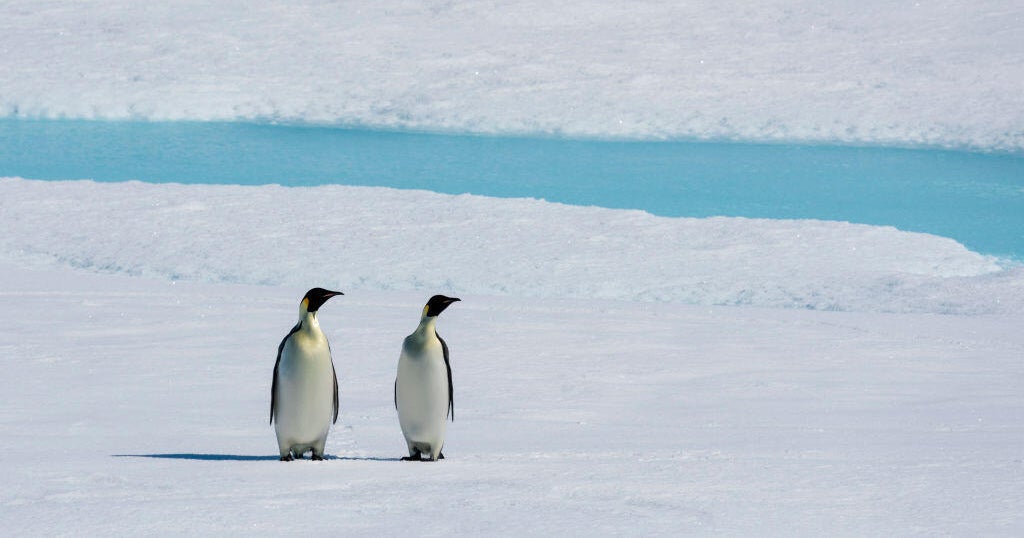Emperor penguin populations in Antartica may be declining faster than the most pessimistic predictions, scientists said after analyzing satellite images of a key part of the continent.
The images, spanning from 2009 to 2024, suggest a decline of 22% in the Antarctic Peninsula, Weddell Sea and Bellingshausen Sea, according to researchers from the British Antarctic Survey and University of Southampton, who published their study in Nature on Tuesday.
The 16 emperor penguin colonies in that part of Antartica represent a third of the global population. The estimated decline compares to an earlier estimate of a 9.5% reduction across Antarctica as a whole between 2009 and 2018.
The researchers now have to see if their assessment in that region of Antartica is true for the rest of the continent.
“There’s quite a bit of uncertainty in this type of work and what we’ve seen in this new count isn’t necessarily symbolic of the rest of the continent,” Dr. Peter Fretwell, the lead author of the study, said in a statement. “But if it is — that’s worrying because the decline is worse than the worst-case projections we have for emperors this century.”
While further analysis is needed, Fretwell told Agence France-Presse the colonies studied were considered representative.
Researchers know that climate change is driving the losses, but the speed of the declines is a particular cause for alarm.
Warming is thinning and destabilizing the ice under the penguins’ feet in their breeding grounds.
Sergio Pitamitz/VW Pics/Universal Images Group via Getty Images
In recent years some colonies have lost all their chicks because the ice has given way beneath them, plunging hatchlings into the sea before they were old enough to cope with the freezing ocean.
Fretwell said the new research suggests penguin numbers have been declining since the monitoring began in 2009. That is even before global warming was having a major impact on the sea ice, which forms over open water adjacent to land in the region.
But he said the culprit is still likely to be climate change, with warming driving other challenges for the penguins, such as higher rainfall or increasing encroachment from predators.
“Emperor penguins are probably the most clear-cut example of where climate change is really showing its effect,” Fretwell said. “There’s no fishing. There’s no habitat destruction. There’s no pollution which is causing their populations to decline. It’s just the temperatures in the ice on which they breed and live, and that’s really climate change.”
Emperor penguins number about a quarter of a million breeding pairs, all in Antarctica, according to a 2020 study.
A baby emperor penguin emerges from an egg kept warm in winter by a male, while the female in a breeding pair embarks on a two-month fishing expedition. When she returns to the colony, she feeds the hatchling by regurgitating and then both parents take turns to forage. To survive on their own, chicks must develop waterproof feathers, a process that typically starts in mid-December.
The new research uses high resolution satellite imagery during the months of October and November, before the region is plunged into winter darkness.
Fretwell said future research could use other types of satellite monitoring, like radar or thermal imaging, to capture populations in the darker months, as well as expand to the other colonies.
He said there is hope that the penguins may go further south to colder regions in the future but added that it is not clear “how long they’re going to last out there.”
Computer models have projected that the species will be near extinction by the end of the century if humans do not slash their planet-heating emissions. The latest study suggests the picture could be even worse.
“We may have to rethink those models now with this new data,” said Fretwell.
But he stressed there was still time to reduce the threat to the penguins.
“We’ve got this really depressing picture of climate change and falling populations even faster than we thought but it’s not too late,” he said. “We’re probably going to lose a lot of emperor penguins along the way, but if people do change, and if we do reduce or turn around our climate emissions, then then we will save the emperor penguin.”
emperor-penguin-population-decline-may-be-worse-than-the-worst-case-projections-scientists-warn















Leave a Reply